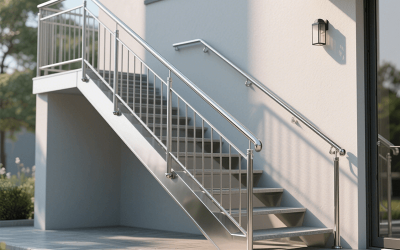Installing a stair railing involves planning, measuring, cutting, and securing the handrail and balusters (spindles) to ensure safety, stability, and compliance with local building codes. Below is a step-by-step guide for installing a stair railing, assuming a standard straight staircase with a handrail and balusters.
1. Check Local Building Codes
- Handrail Height: 34–38 inches above the nose of the stair treads (measured vertically).
- Baluster Spacing: Maximum 4 inches between balusters to prevent a 4-inch sphere from passing through (child safety).
- Guardrail Height: Minimum 36 inches for residential stairs (if guarding an open side).
- Handrail Grip: Must be graspable, typically 1.25–2 inches in diameter or equivalent.
- Load Requirements: Handrail must withstand 200 lbs of lateral force.
- Verify requirements with your local building authority (e.g., International Residential Code).
2. Gather Tools and Materials
- Tools:
- Tape measure
- Level (4-foot and small torpedo level)
- Miter saw or hand saw
- Drill with bits
- Stud finder
- Pencil and chalk line
- Screwdriver or impact driver
- Angle finder or protractor
- Safety gear (gloves, goggles)
- Materials:
- Handrail (wood, metal, or composite)
- Balusters (pre-drilled or square-top, depending on system)
- Newel posts (for ends or landings, if needed)
- Brackets or handrail connectors
- Wood screws (e.g., 2.5–3 inches for brackets)
- Wood glue (for added stability)
- Finishing nails or dowel screws (for balusters)
- Sandpaper, paint, or stain (for finishing)
- Fillets (spacer strips for bottom of handrail, if required)
3. Measure and Plan the Layout
- Determine Handrail Height:
- Measure 34–38 inches vertically from the nose of a tread (front edge of the step).
- Mark this height on the wall or newel posts at the top and bottom of the stairs.
- Use a chalk line or laser level to mark a consistent line along the stair angle.
- Calculate Handrail Angle:
- Use an angle finder to measure the stair pitch (typically 30–40°).
- Alternatively, place a level on the stairs and measure the angle where it meets a vertical surface.
- Locate Studs (for Wall-Mounted Rails):
- Use a stud finder to locate wall studs for securing brackets (typically 16 inches apart).
- Mark stud locations along the handrail line.
- Baluster Placement:
- Calculate spacing: Divide the horizontal run between newel posts by the number of balusters to ensure gaps are <4 inches.
- Example: For a 10-foot (120-inch) run, with 2-inch-wide balusters, aim for ~3.5-inch gaps:Number of gaps = 120 ÷ Baluster width+Max gap ≈ 120÷(2+4) ≈ 20 balustersAdjust for even spacing.
4. Install Newel Posts (if Needed)
- Anchor Newel Posts:
- Secure bottom newel post to the floor or stair tread using a newel post fastener kit (e.g., lag bolts or keylock systems).
- For the top post, secure to the floor or a sturdy stair stringer.
- Use a level to ensure posts are plumb (vertically straight).
- Reinforce:
- Add wood glue and screws for extra stability.
- Drill pilot holes to prevent splitting.
5. Cut and Fit the Handrail
- Measure Handrail Length:
- Measure the distance between newel posts (or wall brackets) along the marked angle.
- Add 2–4 inches for overhangs at each end (optional, for aesthetics).
- Cut Handrail:
- Use a miter saw to cut the handrail to length at the stair angle (e.g., 31° for both ends).
- Ensure ends are parallel to newel posts or walls for a flush fit.
- Dry-Fit:
- Temporarily place the handrail to check alignment and length.
6. Install Balusters
- Mark Baluster Positions:
- On the tread, mark where each baluster will sit, ensuring <4-inch gaps.
- Use a level to extend these marks vertically to the handrail underside.
- Cut Balusters:
- Measure the distance from the tread to the handrail at the stair angle.
- Cut balusters to length, with angled cuts (matching stair pitch) at the top to fit the handrail’s underside.
- Attach Balusters:
- Bottom: Drill pilot holes into the tread and secure balusters with screws or dowel screws. For pre-drilled systems, use baluster shoes or glue.
- Top: Secure to the handrail with finishing nails, screws, or fillets (spacer strips in the handrail groove).
- Ensure each baluster is plumb using a level.
- Alternative (Pre-Assembled): Some systems have balusters pre-attached to a sub-rail, which is then secured to the handrail and treads.
7. Secure the Handrail
- To Newel Posts:
- Drill pilot holes and use handrail bolts or screws to attach the handrail to newel posts.
- Add wood glue for extra strength.
- To Wall (Wall-Mounted):
- Install handrail brackets at stud locations (every 3–4 feet).
- Secure brackets to the wall with screws, then attach the handrail to brackets using screws or clips.
- Check Alignment:
- Use a level to ensure the handrail is parallel to the stair angle and at the correct height.
8. Finishing Touches
- Sand and Smooth:
- Sand rough edges on the handrail, balusters, and newel posts.
- Paint or Stain:
- Apply paint, stain, or varnish to match your staircase or decor.
- Use painter’s tape to protect surrounding areas.
- Caulk and Fill:
- Fill screw holes with wood filler and sand smooth.
- Caulk gaps between the handrail and wall or newel posts for a polished look.
- Install Baluster Shoes (if applicable):
- Add decorative shoes to cover baluster bases for a cleaner appearance.
9. Inspect and Test
- Check Stability:
- Apply pressure to the handrail and balusters to ensure they’re secure.
- Tighten any loose screws or fittings.
- Verify Code Compliance:
- Measure handrail height, baluster spacing, and guardrail height.
- Ensure the handrail is graspable and smooth (no sharp edges).
- Safety Check:
- Confirm no wobbling or weak points.
- Test headroom (minimum 80 inches above treads).
10. Clean Up
- Remove debris, sawdust, and tools.
- Vacuum or sweep the staircase.
- Dispose of any waste materials responsibly.
Additional Tips
- Pre-Assembled Kits: Consider pre-made railing systems (e.g., from Home Depot or StairSupplies) for easier installation, especially for beginners.
- Curved or Spiral Stairs: Use flexible handrails or consult a professional for custom bending and fitting.
- Metal Railings: Follow similar steps but use metal-specific tools (e.g., hacksaw, metal screws) and ensure proper grounding for safety.
- Professional Help: For complex staircases (e.g., floating stairs, glass balusters), hire a contractor to ensure structural integrity.
- Resources: Watch tutorials on YouTube (e.g., This Old House) or use manufacturer guides for specific railing systems.
Example Installation
- Staircase: 10-foot run, 31° pitch, 36-inch-wide stairs.
- Materials: Oak handrail, square balusters, two newel posts.
- Steps:
- Mark 36-inch height from tread noses; snap chalk line at 31°.
- Secure newel posts to floor and top tread with lag bolts.
- Cut handrail to 10.5 feet with 31° mitered ends.
- Space 20 balusters (~3.5-inch gaps); cut to fit (angled tops).
- Screw balusters to treads and handrail; secure handrail to newel posts.
- Sand, stain, and caulk for finish.
- Result: Code-compliant, sturdy railing with a polished look.









